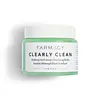What's inside
What's inside
 Key Ingredients
Key Ingredients

 Benefits
Benefits

 Concerns
Concerns

 Ingredients Side-by-side
Ingredients Side-by-side

Coco-Caprylate/Caprate
EmollientRicinus Communis Seed Oil
MaskingCaprylic/Capric Triglyceride
MaskingHelianthus Annuus Seed Oil
EmollientHydrogenated Coco-Glycerides
EmollientGlyceryl Citrate/Lactate/Linoleate/Oleate
EmulsifyingCalophyllum Inophyllum Seed Oil
AntimicrobialBambusa Arundinacea Stem Powder
AbrasivePolyglyceryl-3 Caprate
EmulsifyingGlyceryl Caprylate
EmollientTocopherol
AntioxidantPolyglyceryl-4 Cocoate
EmollientGlyceryl Undecylenate
EmollientGlycine Soja Oil
EmollientLavandula Angustifolia Oil
MaskingRosmarinus Officinalis Leaf Oil
MaskingRosa Damascena Flower Oil
MaskingCedrus Atlantica Bark Oil
MaskingSalvia Sclarea Oil
MaskingCitrus Aurantium Dulcis Peel Oil
MaskingCoco-Caprylate/Caprate, Ricinus Communis Seed Oil, Caprylic/Capric Triglyceride, Helianthus Annuus Seed Oil, Hydrogenated Coco-Glycerides, Glyceryl Citrate/Lactate/Linoleate/Oleate, Calophyllum Inophyllum Seed Oil, Bambusa Arundinacea Stem Powder, Polyglyceryl-3 Caprate, Glyceryl Caprylate, Tocopherol, Polyglyceryl-4 Cocoate, Glyceryl Undecylenate, Glycine Soja Oil, Lavandula Angustifolia Oil, Rosmarinus Officinalis Leaf Oil, Rosa Damascena Flower Oil, Cedrus Atlantica Bark Oil, Salvia Sclarea Oil, Citrus Aurantium Dulcis Peel Oil
Cetyl Ethylhexanoate
EmollientSynthetic Wax
AbrasiveCoco-Caprylate/Caprate
EmollientCaprylic/Capric Triglyceride
MaskingPolyglyceryl-10 Dioleate
EmulsifyingPolyglyceryl-6 Dicaprate
EmulsifyingSorbitan Oleate Decylglucoside Crosspolymer
CleansingHelianthus Annuus Seed Oil
EmollientMoringa Oleifera Seed Extract
Skin ConditioningCarica Papaya Fruit Extract
Skin ConditioningMoringa Oleifera Leaf Water
Skin ConditioningPentylene Glycol
Skin ConditioningGluconolactone
Skin ConditioningPolyglyceryl-6 Oleate
EmulsifyingGlyceryl Citrate/Lactate/Linoleate/Oleate
EmulsifyingSorbitan Sesquioleate
EmulsifyingPotassium Olivate
EmulsifyingGlyceryl Caprylate
EmollientPolyglyceryl-3 Caprate
EmulsifyingPolyglyceryl-4 Cocoate
EmollientSodium Chloride
MaskingButylene Glycol
HumectantWater
Skin ConditioningSodium Benzoate
MaskingMaltodextrin
AbsorbentGlyceryl Laurate
EmollientCetyl Ethylhexanoate, Synthetic Wax, Coco-Caprylate/Caprate, Caprylic/Capric Triglyceride, Polyglyceryl-10 Dioleate, Polyglyceryl-6 Dicaprate, Sorbitan Oleate Decylglucoside Crosspolymer, Helianthus Annuus Seed Oil, Moringa Oleifera Seed Extract, Carica Papaya Fruit Extract, Moringa Oleifera Leaf Water, Pentylene Glycol, Gluconolactone, Polyglyceryl-6 Oleate, Glyceryl Citrate/Lactate/Linoleate/Oleate, Sorbitan Sesquioleate, Potassium Olivate, Glyceryl Caprylate, Polyglyceryl-3 Caprate, Polyglyceryl-4 Cocoate, Sodium Chloride, Butylene Glycol, Water, Sodium Benzoate, Maltodextrin, Glyceryl Laurate
 Reviews
Reviews

Ingredients Explained
These ingredients are found in both products.
Ingredients higher up in an ingredient list are typically present in a larger amount.
This ingredient is an emollient, solvent, and texture enhancer. It is considered a skin-softener by helping the skin prevent moisture loss.
It helps thicken a product's formula and makes it easier to spread by dissolving clumping compounds.
Caprylic Triglyceride is made by combining glycerin with coconut oil, forming a clear liquid.
While there is an assumption Caprylic Triglyceride can clog pores due to it being derived from coconut oil, there is no research supporting this.
Learn more about Caprylic/Capric TriglycerideCoco-Caprylate/Caprate is created from fatty coconut alcohol, caprylic acid, and capric acid.
It is a lightweight emollient. Emollients create a thin barrier on the skin to trap moisture in. This helps keep your skin hydrated and soft.
Once applied, Coco-Caprylate/Caprate is absorbed quickly and leaves a silky feel.
Coco-Caprylate/Caprate may not be fungal acne safe.
Learn more about Coco-Caprylate/CaprateGlyceryl Caprylate comes from glycerin and caprylic acid, a fatty acid from coconut. It has emollient and emulsifier properties.
As an emollient, it helps hydrate your skin. Emollients work by creating a barrier on your skin to trap moisture in, helping to keep your skin soft and smooth.
On the other hand, emulsifiers prevent ingredients (such as oil and water) from separating.
Learn more about Glyceryl CaprylateGlyceryl Citrate/Lactate/Linoleate/Oleate isn't fungal acne safe.
Helianthus Annuus Seed Oil is the oil derived from the seeds of a Sunflower. Sunflower seed oil is non-fragrant. It is an emollient, meaning it helps to soften the skin.
Sunflower seed oil contains many fatty acids. The fatty acids found in sunflower seeds include (from highest amount to least): linoleic acid, myristic acid, palmitic acid, stearic acid, arachidic acid, oleic acid, and linolenic acid.
These fatty acids help the skin create ceramides. Ceramides play a role in repairing the skin barrier.
Helianthus Annuus Seed Oil helps moisturize the skin. This in turn helps the skin look more rejuvenated and smoother.
Sunflowers are rich in vitamin E.
Historians believe Indigenous cultures of North America domesticated sunflowers before corn. Thus they relied on sunflower oil for a variety of uses. One such use is moisturizing skin and hair.
Sunflower seed oil may not be fungal acne safe. We recommend speaking with a professional if you have any concerns.
Learn more about Helianthus Annuus Seed OilWe don't have a description for Polyglyceryl-3 Caprate yet.
Polyglyceryl-4 Cocoate isn't fungal acne safe. It can be bad for dry skin.